Supermicro SYS-E100-12T-H Review: Fanless Tiger Lake for Embedded Applications
by Ganesh T S on June 8, 2022 8:00 AM EST- Posted in
- Systems
- Fanless
- Embedded
- Supermicro
- Passive Cooling
- Tiger Lake
GPU Performance
GPUs in embedded PCs are rarely used for taxing workloads. In certain applications, they could be used for video processing and other allied functions. Some use-cases such as digital kiosks may require limited 3D graphics capabilities. Our GPU performance evaluation typically involves gaming workloads, and for select PCs, GPU compute. Prior to that, a look at the capabilities of the GPU in the SYS-E100-12T-H is warranted.
The Intel Iris Xe Graphics in the Supermicro SYS-E100-12T-H is an integrated GPU based on a reworked scalable architecture. The performance of the iGPU is miles ahead of previous iGPUs from both Intel and AMD, as the benchmarks below show.
GFXBench
The DirectX 12-based GFXBench tests from Kishonti are cross-platform, and available all the way down to smartphones. As such, they are not very taxing for discrete GPUs and modern integrated GPUs. We processed the offscreen versions of the 'Aztec Ruins' benchmark.
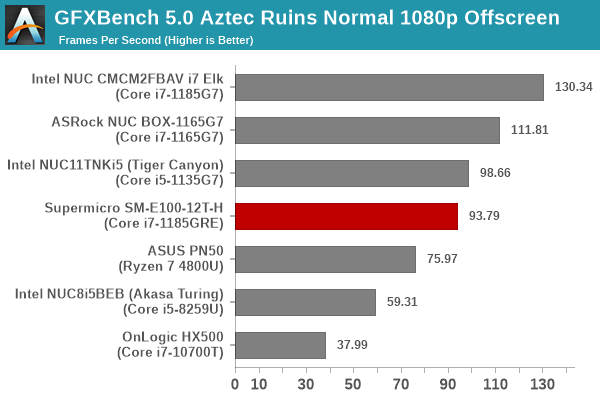
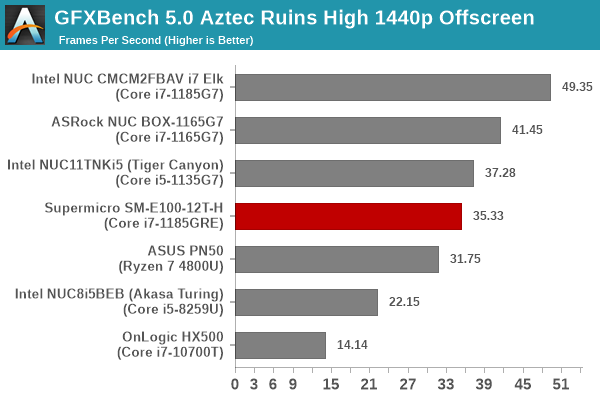
The key takeaway here is that the Iris Xe graphics in the SYS-E100-12T-H outclasses AMD's Renoir in the ASUS PN50 despite having a TDP handicap. In the battle of iGPUs, the Tiger Lake systems outscore the Renoir / Cofee Lake systems handsomely, and within themselves, get ordered based on GPU clock speeds and available power budgets.
UL 3DMark
Four different workload sets were processed in 3DMark - Fire Strike, Time Spy, Night Raid, and Wild Life.
3DMark Fire Strike
The Fire Strike benchmark has three workloads. The base version is meant for high-performance gaming PCs. It uses DirectX 11 (feature level 11) to render frames at 1920 x 1080. The Extreme version targets 1440p gaming requirements, while the Ultra version targets 4K gaming system, and renders at 3840 x 2160. The graph below presents the overall score for the Fire Strike Extreme and Fire Strike Ultra benchmark across all the systems that are being compared.
| UL 3DMark - Fire Strike Workloads | |||
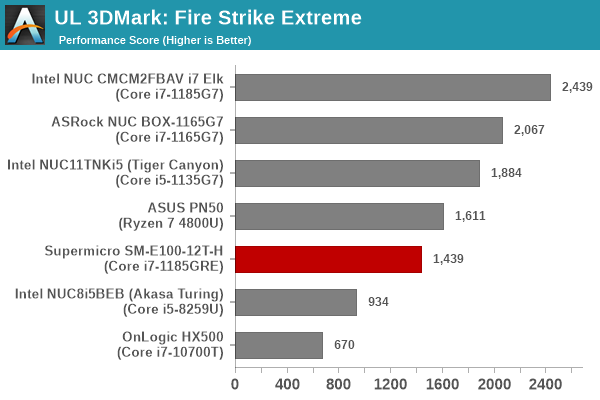
The Fire Strike benchmark sees the Renoir iGPU and the SM-E100-12T-H's Iris Xe perform very similarly. Otherwise, the observations made in the GFXBench subsection hold true here.
3DMark Time Spy
The Time Spy workload has two levels with different complexities. Both use DirectX 12 (feature level 11). However, the plain version targets high-performance gaming PCs with a 2560 x 1440 render resolution, while the Extreme version renders at 3840 x 2160 resolution. The graphs below present both numbers for all the systems that are being compared in this review.
| UL 3DMark - Time Spy Workloads | |||
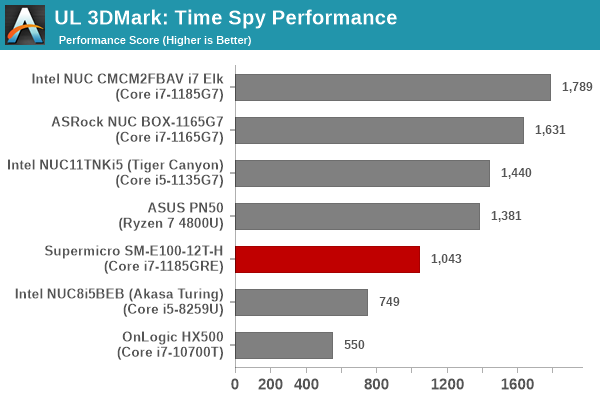
The Time Spy workloads see the Renoir iGPU take a clear lead over the Iris Xe in the SM-E100-12T-H. However, the higher power budget available to other Tiger Lake systems see them leave the Renoir iGPU well behind.
3DMark Wild Life
The Wild Life workload was initially introduced as a cross-platform GPU benchmark in 2020. It renders at a 2560 x 1440 resolution using Vulkan 1.1 APIs on Windows. It is a relatively short-running test, reflective of mobile GPU usage. In mid-2021, UL released the Wild Life Extreme workload that was a more demanding version that renders at 3840 x 2160 and runs for a much longer duration reflective of typical desktop gaming usage.
| UL 3DMark - Wild Life Workloads | |||

The Wild Life workload behaves similar to GFXBench - the ASUS PN50 and SM-E100-12T-H perform similarly, with a slight edge for the latter. The other Tiger Lake systems round out the top spots.
3DMark Night Raid
The Night Raid workload is a DirectX 12 benchmark test. It is less demanding than Time Spy, and is optimized for integrated graphics. The graph below presents the overall score in this workload for different system configurations.
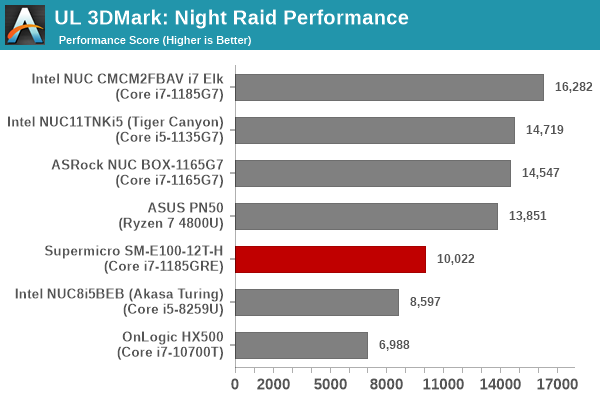
The Night Raid workload behaves similar to Time Spy - the ASUS PN50 gets a clear lead over the SM-E100-12T-H, but the other Tiger Lake systems are well ahead with their higher power budget.











16 Comments
View All Comments
thestryker - Wednesday, June 8, 2022 - link
I believe they resolved all of these issues with the third revision of the V. It looks like the IT was released later and is a bit different so it seems like a fairly safe bet this one should be okay.rachana - Friday, July 29, 2022 - link
thanksabufrejoval - Thursday, June 9, 2022 - link
Got an Intel NUC variant with the i7-1165G7 (as well as G8/G10 predecessors).Biggest advantage of recent NUCs is the ability to tune PL1/2/TAU and fan parameters freely.
PL2 is set to 67 Watts by default and results in a howler, so I spent some time to find propper settings all around, that would a) give me the highest short-term peak power possible for interactive stuff b) never raise the fan to the point where it's 'noticeable'. 50/28 Watts and 10 seconds of TAU have the fan stay below 3200rpm and work for me.
The system runs as a mini server 24/7 in my home-lab, so I've always looked for fully passive, but getting that beyond Atoms has been very tough if not impossible, e.g. Akasa never made a chassis to match my Tiger Canyon. But with those fan settings I can manage, even if it means the CPU will occasionally hit 100°C.
The 96EU Tiger Lake iGPU seems designed to top out at 16 Watts: it won't ever use more but it gets priority over CPU cores, which will have to make do with what's left over. If indeed SuperMicro fixes PL1/2 at 15 Watts, that will not make for a smooth experience. I've just tried that on my NUC and the stuttering is awful. Game engines most likely won't be able to compensate the fight over power budget allocations. Atom iGPUs up to Jasper Lake likewise seem fixed at 5 Watts.
But then dissipating 15 Watts at high ambients might still is a challenge so to stay with the form factor they may have had no choice. On max power the TigerLake mobile SoCs will happily burn 80 Watts for quite a while and that would require a truely massive chassis.
AFAIK ECC DRAM support simply isn't available on any Tiger Lake silicon, not just fused off like usual, so there is nothing SuperMicro could do to support it.
ECC support on AMD APU seems rather bad, too. Pro-variants of AM4 APUs have it, but I've yet to find any board with a soldered -H or -U APU that supports ECC DRAM for ease of mind in a microserver setup. I'd love to know if the required 'pins' on the BGA are even available.
kgardas - Thursday, June 9, 2022 - link
Your "AFAIK ECC DRAM support..." is wrong here. There are plethora of lines of TGL, but one is for embedded devices. You can distinct them by seeing 'G7E' and 'GRE' suffexes in name. Now, while G7E is with zero ECC RAM support, 'GRE' is where live becomes interesting as this line supports In-Band ECC. This In-Band ECC is just an Intel way how to support ECC with non-ECC RAM sticks. Part of RAM size is dedicated for ECC bits and SoC's memory controller make that working.And now, the review is about unit with i7-1185GRE -- so you know why have I asked about the feature.
fazalmajid - Thursday, June 9, 2022 - link
Every manufacturer should adopt the locking power barrel connector.bansheexyz - Thursday, June 9, 2022 - link
I always wondered why mini-itx didn't evolve into something more like this, where the case itself is part of the spec and acts as a giant heatsink. If you're going to have a fan, an internal PSU, and a video card, then just get an ATX board? Instead, the only way to get this small and thin is to pay a $700 premium for custom everything.